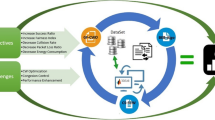Abstract
In Wireless Mesh Networks (WMN), at the time of network consignment and bandwidth registration, the active network consignment method did not take into consideration the intrusion, congestion load and bandwidth necessities as a whole. The significance centred bandwidth registration methods result in famishment of slightest significance congestion. Hence in this paper, we propose a Joint Channel Assignment and Bandwidth Reservation using Improved FireFly Algorithm (JCABR-IFA) in WMN. Initially the priority of each node is determined based on the channel usage, future interference and link congestion probability metrics. The bandwidth is allocated proportional to the node priority and the total number of traffic flows served by the requested node. For channel assignment and path selection, the improved FireFly Algorithm (IFA) is used. The objective function of IFA is determined in terms of link capacity, interference and flow conservation constraints. Then the channels and the path which minimize the objective function are selected by applying IFA. By simulation results we show that the proposed technique minimizes the traffic and enhances the channel efficiency.














Similar content being viewed by others
Data Availability
The authors don’t use any third party data materials.
Code Availability
The implementation code for this research was available with the authors.
References
Ding, Y., & **ao, L. (2011). Channel allocation in multi-channel wireless mesh networks. Computer Communication, 34, 803–815.
Jain, S., Tripathi, V. S., & Tiwari, S. (2013). Bandwidth allocation based on traffic load and interference in IEEE 802.16 mesh networks. Journal of Engineering. https://doi.org/10.1155/2013/197295
Skalli, H., Ghosh, S., Das, S. K., Lenzini, L., & Conti, M. (2007). Channel assignment strategies for multiradio wireless mesh networks: issues and solutions. IEEE Communications Magazine, 45, 86–95.
Ko, B.-J., Misra, V., Padhye, J., & Rubenstein, D. (2007). Distributed channel assignment in multi-radio 802.11. Mesh Networks. https://doi.org/10.1109/WCNC.2007.727
Ali, A., Ahmed, M. E., Piran, M. J., & Suh, D. Y. (2014). Resource optimization scheme for multimedia-enabled wireless mesh networks. Sensors, 14, 14500–14525.
Zhang, D., Zhu, Y., Liu, S., Zhang, X., & Song, J. (2016). Multi-radio multi-channel (MRMC) resource optimization method for wireless mesh network. Journal of Information Science and Engineering, 32, 495–514.
Ding, Y., Pongaliur, K., & **ao, L. (2013). Channel allocation and routing in hybrid multichannel multiradio wireless mesh networks. IEEE Transactions on Mobile Computing, 12, 206–218.
Wang, J., Shi, W., Cui, K., **, F., & Li, Y. (2015). Partially overlapped channel assignment for multi-channel multi-radio wireless mesh networks. EURASIP Journal Onwireless Communications and Networking, 2015(25), 2015.
Yang, X.-S., & He, X. (2013). Firefly algorithm: recent advances and applications. International Journal of Swarm Intelligence, 1, 36–50.
Alicherry, M., Bhatia, R., & Li, L. (2006). Joint channel assignment and routing for throughput optimization in multiradio wireless mesh networks. IEEE Journal on Selected Areas in Communications. https://doi.org/10.1145/10808291080836
Jasmine David, D., Jegathesan, V., Roopa Jayasingh, J., (2019). Performance of dynamic priority based interference aware channel allocation in wireless mesh networks for energy conservation, International Journal of Innovative Technology and Exploring Engineering (IJITEE), 9, 1.
Rad, A. H. M., & Wong, V. W. S. (2006). Joint optimal channel assignment and congestion control for multi-channel wireless mesh networks. IEEE International Conference on Communications, 5, 1984–1989.
Ca, Z., Huang, Q., & Wu, C. Q. (2020). Maximize concurrent data flows in multi-radio multi-channelwireless mesh networks. Computer Science and Information Systems, 17(3), 759–777.
Lavanya, M., Bindu, C. S., & Kumar, G. V. (2019). Internet traffic based channel selection in multi-radio multi-channel wireless mesh networks. International Journal of Communication Networks and Information Security (IJCNIS), 11(2), 262–269.
Bongsu, R. H., Mohammed, A., & Mohamed, M. A. (2019). Recent trends in channel assignment algorithms for multi-radio multi-channel in wireless mesh network. International Journal of Recent Technology and Engineering (IJRTE), 7(5S4), 656–659.
Hassan, W., & Farag, T. (2020). Adaptive allocation algorithm for multi-radio multi-channel wireless mesh networks. Future Internet, 12, 27.
Ismael, B. M., Ngadi, A. B., & Sharif, J. B. M. (2021). An optimized weighted node ranking scheme for channel assignment in wireless mesh networks using the genetic algorithm. IEEE International Conference on Data Science and Its Applications (ICoDSA). https://doi.org/10.1109/ICoDSA53588.2021.9617477
Benni, N. S., & Manvi, S. S. (2022). Channel allocation scheme to mitigate interference in 5G backhaul wireless mesh networks. IEEE International Conference on Data Science Agents & Artificial Intelligence (ICDSAAI), 1, 1–5.
Li, Z., Zhang, D., & Shi, H. (2021). Link interference and route length based dynamic channel allocation algorithm for multichannel wireless mesh networks. Wireless Communications and Mobile Computing, 2021, 8.
Funding
This research was not supported by any funding agency.
Author information
Authors and Affiliations
Corresponding author
Ethics declarations
Conflict of interest
The authors don’t have any conflict of Interest.
Additional information
Publisher's Note
Springer Nature remains neutral with regard to jurisdictional claims in published maps and institutional affiliations.
Rights and permissions
Springer Nature or its licensor (e.g. a society or other partner) holds exclusive rights to this article under a publishing agreement with the author(s) or other rightsholder(s); author self-archiving of the accepted manuscript version of this article is solely governed by the terms of such publishing agreement and applicable law.
About this article
Cite this article
Appini, N.R., Reddy, A.R. Joint Channel Assignment and Bandwidth Reservation Using Improved FireFly Algorithm (IFA) in Wireless Mesh Networks (WMN). Wireless Pers Commun 131, 455–470 (2023). https://doi.org/10.1007/s11277-023-10439-8
Accepted:
Published:
Issue Date:
DOI: https://doi.org/10.1007/s11277-023-10439-8




